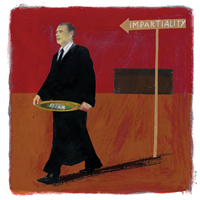Watch What You Ask For

Illustration by Lino
“Therapeutic” or “problem-solving” courts are the product of an idea that a “one-size-fits-all” approach to justice doesn’t always work—especially in dealing with cases involving drug or alcohol use, domestic violence, juveniles, homelessness or mental health.
In a problem-solving court, the judge works with a team of experts and community members to craft individualized case plans. Each plan may involve treatment programs, counseling and substance-abuse screenings to address underlying problems. The offender is closely supervised and, if he or she successfully complies with the plan, criminal sanctions may be reduced or dismissed.
The Center for Court Innovation in New York City estimates there are now more than 2,500 problem-solving courts in the U.S. Growing support for these courts is bolstered by the public’s recognition that they are capable of addressing certain complex social issues in a case better than traditional courts. Problem-solving courts also help both offenders and victims navigate legal structures that often seem overwhelming.
But problem-solving courts face unique financial circumstances, points out the ABA Standing Committee on Ethics and Professional Responsibility in its Formal Opinion 08-452 (Oct. 17, 2008) (PDF). “Although the staffing and physical space for the court typically are supported by regular governmental funding,” states the committee, “government funds may not support the varied alternative remedies that these courts employ.”
As a result, judges working with those courts “find themselves being urged to engage in efforts to raise private funding, through applications for grants or through solicitation of funds or other donations from private individuals or organizations.”
Although the ABA Model Code of Judicial Conduct (as revised in 2007) does not specifically prohibit judges from engaging in fundraising on behalf of courts, a number of provisions limit just what those efforts may entail. The most pertinent rule is 3.7, even though most of its provisions “address conduct that could at most be described as ‘indirect’ involvement in fundraising.”
Rule 3.7 permits a judge to solicit contributions on behalf of government entities and nonprofit organizations concerned with the administration of justice—along with other educational, religious, charitable, fraternal and civic nonprofit organizations—but only from family members and other members of the judiciary over whom the judge does not exercise supervisory or appellate authority. Rule 3.7 limits other activities of judges to organizations specifically concerned with the law, the legal system or the administration of justice.
HOW IS THIS GOING TO LOOK?
But these activities also are subject to the requirements of Rule 3.1, which prohibits judges from engaging in extrajudicial activities that would interfere with judicial duties, lead to frequent disqualifications, or appear to undermine the judge’s independence, integrity or impartiality.
In addition, Rule 1.2 of the Model Code of Judicial Conduct requires a judge to at all times act in a manner that promotes public confidence in the independence, impartiality and integrity of the judiciary, and to avoid even the appearance of impropriety.
A judge must consider whether questions about the appearance of partiality are raised when she learns that either parties or lawyers who appear before her in court have made contributions in response to her solicitations. The test is whether presiding over the matter would create in reasonable minds a perception that the judge violated the judicial code or engaged in other conduct that reflects adversely on the judge’s honesty, impartiality, temperament or fitness to serve as a judge. In most cases such contributions are unlikely to raise concerns, states the opinion, but a judge would be “well-advised” to take into account both the size and the importance of the contributions in deciding whether to continue presiding over the case.
The ABA House of Delegates adopted the current version of the Model Code in February 2007. So far, five states have adopted the revised code, and 35 others have initiated reviews of their existing codes.
Eileen Libby is associate ethics counsel for the ABA Center for Professional Responsibility.



